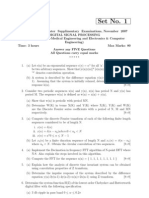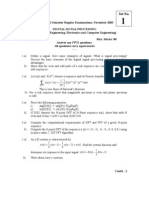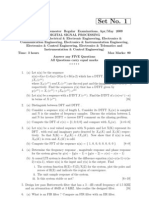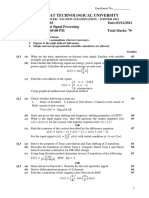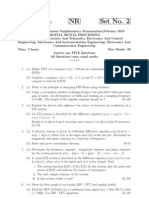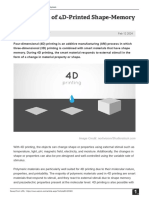ENG4200_02_Transforms_Tutorial
Uploaded by
lichneoENG4200_02_Transforms_Tutorial
Uploaded by
lichneoTutorial-02
Transforms
2.1 z-Transform Tables:
(a) Use the z-transform table to find X(z) of the following functions:
i)
ii)
iii)
(b) Find and simplify the followingz-transforms:
i)
ii)
iii)
(c) Find for the following z-transform functions:
i)
ii)
iii)
(d) Use and to prove
Advanced Engineering Mathematics [ENG4200] Page 1 of 5
Tutorial-02
2.2 Solving difference equations:
(a) Solve the difference equation with initial condition .
(b) Solve the difference equation with initial condition .
(c) In the Newton law of heating and cooling model, . Given the
parameters and initial condition , use the z-transform to find the solution.
(d) In the value of an annuity due model, .Given the parameters
, use thez-transform to find the solution.
(e) Consider the system of difference equations
with the initial conditions .Usez-transform to find x[n] and y[n].
(f) Consider the system of difference equations
with the initial conditions . Usez-transform to find x[n] and y[n].
Advanced Engineering Mathematics [ENG4200] Page 2 of 5
Tutorial-02
2.3 System Response:
(a) Consider a discrete time system where the input-output relation is described by:
y[n]-5y[n-1]+6y[n-2] = x[n]+3x[n-1]+5x[n-2]
i) Identify the order of the system.
ii) Assuming zero initial conditions, determine the system transfer function.
iii) Evaluate the system stability with the help of z-plane.
iv) Find the system response if the system is excited by an impulse.
(b) A linear time-invariant system is given by the feedback connection shown in the diagram below,
where
i) Find the transfer function of the overall system and comment on its stability.
ii) Determine the unit-pulse response of the overall system.
iii) Compute the step response of the overall system.
iv) Compute y[n] when x[n] = (0.5)n u[n] with y[-1] = -3, y[-2] = 4.
(c) The input x[n] = (0.5)nu[n] is applied to a linear time-invariant discrete-time system with the
initial conditions y[-1] = 8 and y[-2] = 4. The resulting output response is
y[n] = 4(0.5)n u[n] − n(0.5)n u[n] − (−0.5)n u[n]
Find the transfer function H(z).
(d) An LTI system has a unit impulse response given by h[n] = (0.5)n u[n]. Using the z-transform,
find the output of this system to an excitation given by x[n] = (n+1)(0.25)n u[n].
[Hint: Find the system transfer function first]
Advanced Engineering Mathematics [ENG4200] Page 3 of 5
Tutorial-02
2.4 Fourier Series:
(a) Find the Fourier series of the periodic function
(b) Sketch the following periodic function and hence find its Fourier series.
(c) Let h be a given number in the interval (0, ). Find the Fourier series of the periodic function:
(d) For the periodic function in question 2.4(a), identify the fundamental frequency of the function
and hence sketch its frequency representation (spectrum).
(e) If the function in 2.4(a) passes through an ideal low-pass filter with cutoff frequency of 2.5 rad/s.
Write down the equation of the filter’s output?
Advanced Engineering Mathematics [ENG4200] Page 4 of 5
Tutorial-02
2.5 Fourier Transform:
(a) Find the Fourier Transform of the function below:
(b) Prove the Fourier Transform of a signal x(t-to) is exp(-jto)X().
(c) Find, using the definition, the Fourier Transform of
[Suggested Assignment: 2.2(e), 2.3(a), 2.4(a), (d), (e)]
Advanced Engineering Mathematics [ENG4200] Page 5 of 5
You might also like
- BASIC SIGNALS & SYSTEMS KEE303 (2022-23)No ratings yetBASIC SIGNALS & SYSTEMS KEE303 (2022-23)3 pages
- Model Question Paper Fifth Semester B.E. (CBCS) Examination: Signals and SystemsNo ratings yetModel Question Paper Fifth Semester B.E. (CBCS) Examination: Signals and Systems2 pages
- Digital Signal Processing - Question BankNo ratings yetDigital Signal Processing - Question Bank3 pages
- R13 - December, 2014 - Regular ExaminationsNo ratings yetR13 - December, 2014 - Regular Examinations3 pages
- Btech Cse It Signals Systems 20161460440120No ratings yetBtech Cse It Signals Systems 201614604401203 pages
- Ee8591 Digital Signal Processing Part B & Part C Questions: Anna University Exams Regulation 2017No ratings yetEe8591 Digital Signal Processing Part B & Part C Questions: Anna University Exams Regulation 20172 pages
- 2022 Set B PYQ Paper - Digital Signal Processing PYQ Paper For Sem V Uploaded by Navdeep Raghav (DU Academic Corner)No ratings yet2022 Set B PYQ Paper - Digital Signal Processing PYQ Paper For Sem V Uploaded by Navdeep Raghav (DU Academic Corner)4 pages
- Eet305 Signals and Systems, December 2023No ratings yetEet305 Signals and Systems, December 20234 pages
- Module 3 - Digital Control Systems ProblemsNo ratings yetModule 3 - Digital Control Systems Problems5 pages
- WWW - Manaresults.Co - In: Code: 13A04302No ratings yetWWW - Manaresults.Co - In: Code: 13A043022 pages
- Student Solutions Manual to Accompany Economic Dynamics in Discrete Time, secondeditionFrom EverandStudent Solutions Manual to Accompany Economic Dynamics in Discrete Time, secondedition4.5/5 (2)
- Couple Therapy Disorganized Attachment DynamicsNo ratings yetCouple Therapy Disorganized Attachment Dynamics11 pages
- 2024-05-30 Monoammonium Phosphate Process Line Costing InformationNo ratings yet2024-05-30 Monoammonium Phosphate Process Line Costing Information7 pages
- 6272 - Dr. D. Y. Patil Pratishthan's D.Y.Patil College of Engineering Akurdi, PuneNo ratings yet6272 - Dr. D. Y. Patil Pratishthan's D.Y.Patil College of Engineering Akurdi, Pune10 pages
- Applications of 4D Printed Shape Memory PolymersNo ratings yetApplications of 4D Printed Shape Memory Polymers4 pages
- Manual For Rehabilitating Large Dams 20170527No ratings yetManual For Rehabilitating Large Dams 20170527123 pages
- Image Compression Using Resilient-Propagation Neural NetworkNo ratings yetImage Compression Using Resilient-Propagation Neural Network5 pages
- Geography Physical and Human Exam of The Third Term 2021 For s3No ratings yetGeography Physical and Human Exam of The Third Term 2021 For s321 pages
- Determine How Energy Flows in An Energy Pyramid (883) Student 08062024No ratings yetDetermine How Energy Flows in An Energy Pyramid (883) Student 080620249 pages
- Trees: Discrete Structures For ComputingNo ratings yetTrees: Discrete Structures For Computing48 pages
- Kinetics of Polyethylene Terephthalate (PET) and Polystyrene (PS) Dynamic PyrolysisNo ratings yetKinetics of Polyethylene Terephthalate (PET) and Polystyrene (PS) Dynamic Pyrolysis9 pages
- Galactic Human - Handbook - Nidle, Sheldon Argüelles, José A - (José Anthony), 1939 - Forres, 1995 - Forres - Altea Pub - 9780952455554 - Anna's ArchiveNo ratings yetGalactic Human - Handbook - Nidle, Sheldon Argüelles, José A - (José Anthony), 1939 - Forres, 1995 - Forres - Altea Pub - 9780952455554 - Anna's Archive180 pages
- cdn3.digialm.com__per_g28_pub_2083_touchstone_AssessmentQPHTMLMode1__2083O2581_2083O2581S6D41479_17438456258438065_TL02202981_2083O2581S6D41479E3.html#No ratings yetcdn3.digialm.com__per_g28_pub_2083_touchstone_AssessmentQPHTMLMode1__2083O2581_2083O2581S6D41479_17438456258438065_TL02202981_2083O2581S6D41479E3.html#37 pages
- Faktor-Faktor Risiko Kejadian Bayi Berat Badan Lahir Rendah (BBLR) Di Wilayah Kerja Puskesmas Pelaihari Tahun 2015No ratings yetFaktor-Faktor Risiko Kejadian Bayi Berat Badan Lahir Rendah (BBLR) Di Wilayah Kerja Puskesmas Pelaihari Tahun 20158 pages
- Ebook 35 Resume Mistakes by Alex BERGHOFEN 2023-02-12No ratings yetEbook 35 Resume Mistakes by Alex BERGHOFEN 2023-02-1233 pages
- Topic 7 Basic Concepts of Urban Drainage: (Urban Stormwater Management Manual For Malaysia) MasmaNo ratings yetTopic 7 Basic Concepts of Urban Drainage: (Urban Stormwater Management Manual For Malaysia) Masma29 pages
- Model Question Paper Fifth Semester B.E. (CBCS) Examination: Signals and SystemsModel Question Paper Fifth Semester B.E. (CBCS) Examination: Signals and Systems
- Ee8591 Digital Signal Processing Part B & Part C Questions: Anna University Exams Regulation 2017Ee8591 Digital Signal Processing Part B & Part C Questions: Anna University Exams Regulation 2017
- 2022 Set B PYQ Paper - Digital Signal Processing PYQ Paper For Sem V Uploaded by Navdeep Raghav (DU Academic Corner)2022 Set B PYQ Paper - Digital Signal Processing PYQ Paper For Sem V Uploaded by Navdeep Raghav (DU Academic Corner)
- Geometric functions in computer aided geometric designFrom EverandGeometric functions in computer aided geometric design
- Student Solutions Manual to Accompany Economic Dynamics in Discrete Time, secondeditionFrom EverandStudent Solutions Manual to Accompany Economic Dynamics in Discrete Time, secondedition
- 2024-05-30 Monoammonium Phosphate Process Line Costing Information2024-05-30 Monoammonium Phosphate Process Line Costing Information
- 6272 - Dr. D. Y. Patil Pratishthan's D.Y.Patil College of Engineering Akurdi, Pune6272 - Dr. D. Y. Patil Pratishthan's D.Y.Patil College of Engineering Akurdi, Pune
- Image Compression Using Resilient-Propagation Neural NetworkImage Compression Using Resilient-Propagation Neural Network
- Geography Physical and Human Exam of The Third Term 2021 For s3Geography Physical and Human Exam of The Third Term 2021 For s3
- Determine How Energy Flows in An Energy Pyramid (883) Student 08062024Determine How Energy Flows in An Energy Pyramid (883) Student 08062024
- Kinetics of Polyethylene Terephthalate (PET) and Polystyrene (PS) Dynamic PyrolysisKinetics of Polyethylene Terephthalate (PET) and Polystyrene (PS) Dynamic Pyrolysis
- Galactic Human - Handbook - Nidle, Sheldon Argüelles, José A - (José Anthony), 1939 - Forres, 1995 - Forres - Altea Pub - 9780952455554 - Anna's ArchiveGalactic Human - Handbook - Nidle, Sheldon Argüelles, José A - (José Anthony), 1939 - Forres, 1995 - Forres - Altea Pub - 9780952455554 - Anna's Archive
- cdn3.digialm.com__per_g28_pub_2083_touchstone_AssessmentQPHTMLMode1__2083O2581_2083O2581S6D41479_17438456258438065_TL02202981_2083O2581S6D41479E3.html#cdn3.digialm.com__per_g28_pub_2083_touchstone_AssessmentQPHTMLMode1__2083O2581_2083O2581S6D41479_17438456258438065_TL02202981_2083O2581S6D41479E3.html#
- Faktor-Faktor Risiko Kejadian Bayi Berat Badan Lahir Rendah (BBLR) Di Wilayah Kerja Puskesmas Pelaihari Tahun 2015Faktor-Faktor Risiko Kejadian Bayi Berat Badan Lahir Rendah (BBLR) Di Wilayah Kerja Puskesmas Pelaihari Tahun 2015
- Ebook 35 Resume Mistakes by Alex BERGHOFEN 2023-02-12Ebook 35 Resume Mistakes by Alex BERGHOFEN 2023-02-12
- Topic 7 Basic Concepts of Urban Drainage: (Urban Stormwater Management Manual For Malaysia) MasmaTopic 7 Basic Concepts of Urban Drainage: (Urban Stormwater Management Manual For Malaysia) Masma














